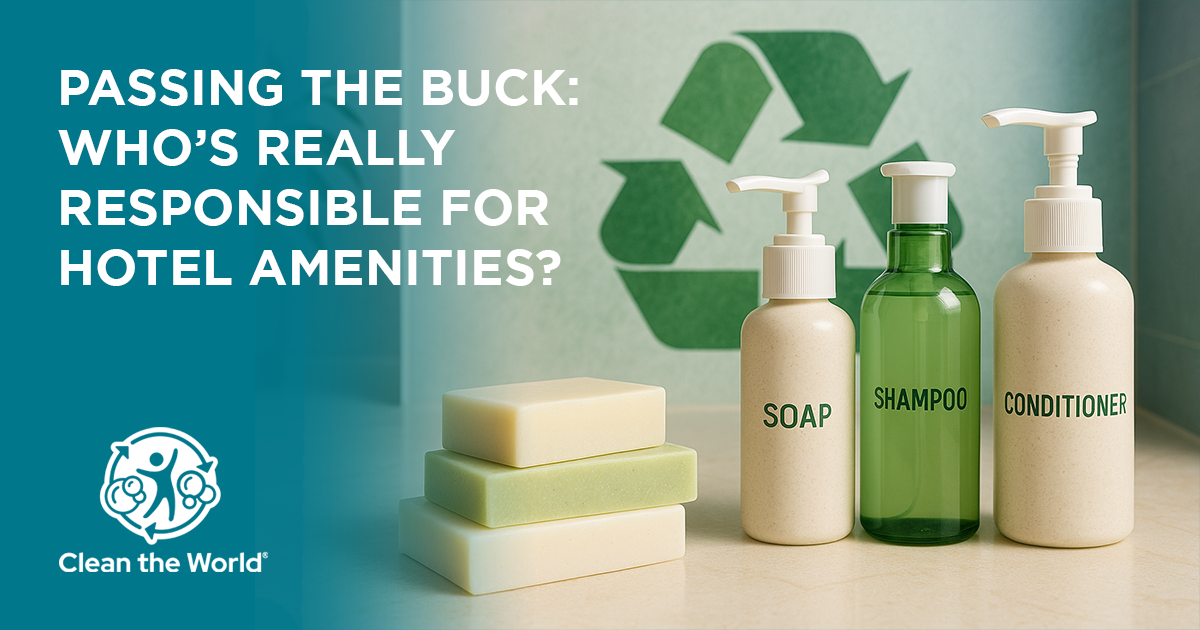As the hospitality industry continues its drive towards more sustainable practices, one particular element remains under increasing scrutiny: the humble hotel bathroom amenity. Who is ultimately responsible for its lifecycle? asks Shawn Seipler, founder and CEO of global hygiene organisation Clean the World.
For years, miniature toiletries have been a hallmark of the hotel experience—symbols of comfort, convenience and luxury. Now, with environmental accountability at the forefront for the hospitality industry, there is growing pressure on the sector to rethink its approach.
Many hotels have responded by replacing miniature bottles with larger refillable dispensers thus significantly reducing single use plastic. Others are sourcing amenity products that are biodegradable, compostable or designed with minimal packaging. These changes are visible and well-intentioned, but do they go far enough?
Awareness: The First Step to Change
The hospitality industry has made noticeable strides toward sustainability. The move from tiny plastic bottles to bulk dispensers is often cited a sustainable win. While this transition reduces visible guestroom waste, it’s not without its own environmental blind spots.
Dispensers may cut down on guestroom waste, but they often rely on bulky plastic refill containers behind the scenes, items that still contribute to plastic waste. In some cases, “larger” bottles are being discarded when half full simply due to housekeeping time pressures or hygiene concerns.
So, have hotels simply shifted the waste problem from what guests see to what they don’t?
If so, who’s truly responsible for solving this? The suppliers? The hotels? The guests?
The answer is simple: everyone.
True sustainability cannot be achieved in isolation. It requires a shared commitment from every stakeholder involved, from product manufacturers and suppliers to hoteliers and the guests themselves.
At Clean the World, we have spent over 15 years helping hotels reduce amenity waste, transforming leftover soaps and hygiene products into a force for good, regardless of their size and shape. Our model goes beyond landfill diversion: it supports global health, reduces carbon emissions and replaces disposability with circularity. Waste becomes impact.
Importantly, we believe change begins with something even more fundamental: awareness. This kind of collective consciousness across the industry considers not just what a product is, but what happens to it after its intended use.
When hotels ask, “What happens to this product when the guest leaves?” they begin a powerful process of rethinking operations, procurement and purpose. Every product has a lifecycle, and it’s in that post-use phase where the greatest opportunity for change often lies.
The industry is, by many accounts, at a pivotal moment. Driven by regulatory change, evolving guest expectations and internal ESG targets, hospitality businesses are re-evaluating every aspect of their supply chains, including the products placed in guest bathrooms. The elimination of single-use amenities can be a win-win: reducing environmental impact and relieving guests from the burden of making sustainable choices during or after their stay.
But let’s be clear, out of sight does not mean out of mind. Today’s travellers are far more savvy, often researching a hotel’s environmental credentials before booking. Sustainability isn’t a nice-to-have anymore, it’s a business imperative.
Many hotels are already very successfully demonstrating what effective change looks like. In the UK, award-winning lifestyle group THE PIG Hotels partnered with Clean the World to recycle all leftover soap across their properties. The results speak for themselves: more than 1,100 kilograms of soap has been diverted from landfill and repurposed into over 22,000 bars for vulnerable communities. The initiative has also saved 30,650 litres of water and avoided over 1.5 tonnes of carbon emissions.
This is not only a model of environmental best practice but also proof that social good that can emerge from even the most routine operational touchpoints.
Designing Better Systems
What is increasingly clear is that the future of sustainability in hospitality cannot rest on the shoulders of hotels alone. The design of more sustainable amenity systems demands full collaboration between hotel brands, suppliers and sustainability partners.
One such example of this collaborative model is the partnership between PPHE Hotel Group and amenity supplier Vanity Group, who together have implemented lifecycle-conscious amenity programmes that place equal emphasis on product origin, recyclability and post-consumption impact. The result is a circular solution that addresses both environmental responsibility and guest expectations. This joined-up thinking is reshaping the future of amenities in a more transparent and thoughtful direction.
Guests too play a pivotal role in driving systematic change. A recent Clean the World survey revealed that 88% of travellers actively factor sustainability into their hotel booking decisions, a clear indication that environmental responsibility is no longer a back-of-house concern, but a front-of-mind expectation.
Yet, despite this growing awareness, 57% of respondents said they believed their hotels would not responsibly dispose of leftover amenities if left behind in the bathroom. This disconnect highlights the importance of communicating transparently. For guests to truly trust and support sustainability efforts, they must be able to see them, and hotels must provide clear, consistent messaging that demonstrates environmental care. Shared knowledge is power.
A Call to Collective Action
Despite growing momentum, the challenge remains substantial. Millions of hotel rooms around the globe continue to generate significant amenity waste daily, and only a small percentage are currently engaged in formal recycling or reuse programmes.
But there is cause for optimism. The industry is better informed, better connected and more solution-oriented than ever before. With organisations like Clean the World offering accessible, impactful programmes, and with guests increasingly attuned to environmental issues, the conditions for progress are stronger than ever.
Ultimately, sustainability is not about shifting blame, it’s about embracing shared responsibility, with each stakeholder recognising the role they play in shaping a more sustainable future, and understanding that change, while incremental, is most effective when it is collaborative.
Awareness is the starting point, it’s the foundation of change and it sparks the right questions: What happens next? How can we mitigate this?
That’s when real, meaningful progress begins.






